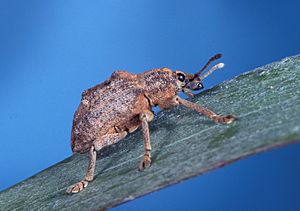Oxyops vitiosa facts for kids
Quick facts for kids Oxyops vitiosa |
|
|---|---|
 |
|
| Melaleuca leaf weevil | |
| Scientific classification | |
| Kingdom: | |
| Phylum: | |
| Class: | |
| Order: | |
| Superfamily: | |
| Family: | |
| Subfamily: |
Curculioninae
|
| Tribe: |
Gonipterini
|
| Genus: |
Oxyops
|
| Species: |
O. vitiosa
|
| Binomial name | |
| Oxyops vitiosa Pascoe, 1870
|
|
The melaleuca leaf weevil (scientific name: Oxyops vitiosa) is a small insect. It is also known as the melaleuca snout beetle. This weevil is a type of weevil from the family Curculionidae.
It loves to eat the leaves and shoots of the broad-leaved paper bark tree. This tree, Melaleuca quinquenervia, comes from Australia. In Australia, it grows in wet areas like swamps. This tree was brought to Florida to help dry out parts of the Everglades.
Contents
Life Cycle of the Melaleuca Weevil
The melaleuca leaf weevil goes through several stages in its life. From egg to adult, each stage is important.
Adult Weevils: Appearance and Habits
Adult weevils are gray and about six to nine millimeters long. That's less than half an inch! Males are a bit smaller than females. You can usually find them on young leaves or new growth of melaleuca trees.
They are good at hiding, so you might not see them easily. But you can spot their presence by the holes they chew. They make holes in buds, leaves, and stems.
Reproduction: Laying Eggs
After mating, the female weevil lays her eggs. She places them one by one or in small groups. Eggs are often found on the tips of young leaves. Sometimes, they are on older leaves or new plant growth.
The eggs are yellow and about one millimeter long. The female covers them with a special liquid. This liquid dries into a hard, dark shell. This shell protects the eggs. A female weevil can live for up to ten months. During this time, she might lay 500 to 1000 eggs. She can lay up to nine eggs each day!
Larvae: The Hungry Stage
The eggs hatch in about a week. The tiny creatures that come out are called larvae. They are yellow when they first hatch. As they grow, they shed their skin four times. This process is called molting.
Older larvae are gray and look a bit like slugs. They get covered in a clear, oily liquid. This liquid turns black as their waste, called faecal material, sticks to it. This black coating might protect them from fire ants and other animals that want to eat them. Larvae often drag a black string of waste behind them.
When they eat, larvae chew through almost all layers of a leaf. They leave behind thin trails that are as wide as their bodies. It takes them about seven weeks to grow. As they get bigger, they move downwards on the plant.
Pupation: Changing Underground
The last larval stage is called the puparium. At this point, the larva stops eating. It crawls or falls to the ground. Then, it finds a good spot underground to change. This change is called pupating.
The larva forms a capsule about ten millimeters wide. This capsule gets covered with soil. The soil sticks to the larva's oily coating. This stage lasts from two to six weeks, usually about four weeks. Weevils can pupate in different types of soil. They do best in sandy, well-drained soils. They don't do well in very wet or flooded areas. This was seen when the weevil was brought to Florida in 1997.
What Do Melaleuca Weevils Eat?
This weevil mainly eats Melaleuca quinquenervia trees. This tree is part of the myrtle family. It is native to Australia. Scientists did tests in Australia to see if the weevil ate other plants. They found very few weevils on other plant types. They found thousands on melaleuca trees.
In lab tests, melaleuca was the only plant where adult weevils could successfully grow. Before the weevil was brought to Florida, it was tested on over 100 local plant species. This included all native Florida plants in the myrtle family. The tests showed that adult weevils might sometimes nibble on other plants. However, they could not reproduce on any other plant tested. This means they only lay eggs and have babies on melaleuca trees.
Melaleuca Weevils: Helping Control Invasive Trees
The melaleuca tree, Melaleuca quinquenervia, was brought to Florida as a pretty plant. It started growing wild around 1906. Later, many were planted to help drain wet parts of the Everglades. But the tree grew too well and spread everywhere. Now, it is considered an invasive species. This means it harms the local ecosystem.
In Florida, the melaleuca tree has no natural enemies that only eat it. So, scientists are looking into bringing certain insects from Australia to help control it. Scientists from the USDA brought four insect species to study them safely. The melaleuca leaf weevil seems to be the most promising.
Both adult weevils and their larvae harm the melaleuca tree's normal growth. This damage might make the trees weaker. This could help other ways of controlling the trees work better. In some test areas where the weevil was released, the melaleuca tree's flowering was reduced by up to 90%. This much damage can help lower the number of seeds the tree produces. This, in turn, helps stop the spread of this invasive tree.

